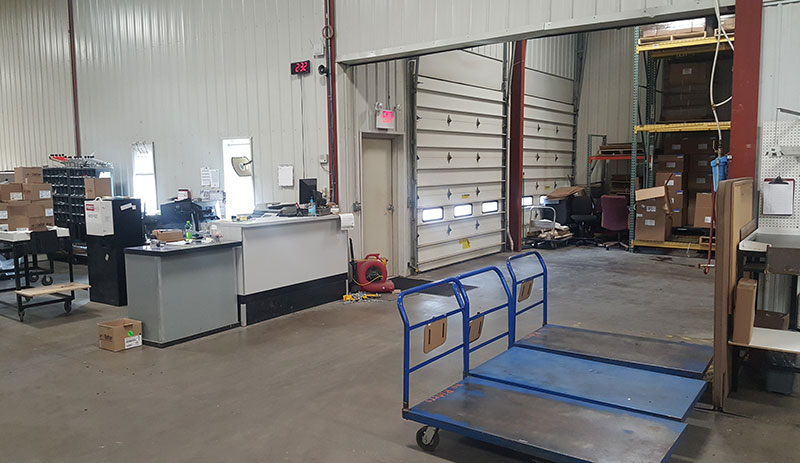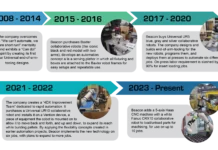by Liz Stevens, contributing writer
Plastics Business
Aregular flow of vehicles approaches the roll-up door at Vital Plastics throughout the course of every work week. The volume varies – some weeks, there may be 125 vehicles, and other weeks may bring as many as 200. Each vehicle disappears inside, and 15 minutes later, it emerges and drives away.
This volume of traffic is not typical for a plastics injection molding operation, but then Vital Plastics is not typical. That stream of vehicles entering and leaving? Those are home-based employees arriving to drop off finished work and pick up parts to assemble. In 2019, 70% of Vital Plastics’ assembly work has been done off-site by home-based assemblers.
The company
Vital Plastics, located just east of Minneapolis in Baldwin, Wisconsin, produces parts for the automotive/transportation, industrial, agriculture, appliance, consumer goods and electronics/telecommunications markets. It has operated with home-based assemblers for 25 years. The company has mastered the art of matching production needs to workers’ capacities, scheduling individual weekly visits for a large crew and streamlining the drop-off/pick-up routine. And, it has fine-tuned the science of adjusting the entire operation to meet the shifting needs of customers and to accommodate the changing availability of workers.
According to George Hauser, president of Vital Plastics, the original founder of the company, Joe Ahlm, began a small assembly business in a garage in 1994. After soon expanding to a larger building, he had an idea, believing that “There are people who can do this in their living room.” A business model was born.
Vital Plastics now uses a mix of automated and hand assembly. “You cannot automate everything,” explained Hauser. “There are just things that do not lend themselves to automation. Either the automation process is too expensive or automation may be affordable, but the low parts volume doesn’t warrant it.” The parts that don’t fit for automation are assembled by hand.
The assemblers
Back in the day, the company recruited home-based assembly employees with ads in the newspaper. These days, the injection molder uses a database to gather and track ongoing online job applications and uses email broadcasting to put out the call for immediate hiring. Working as a home-based employee for Vital Plastics is so popular in this community that the last time the company put out a call to hire, 30 employee slots were filled in five minutes.
Employees include retirees, stay-at-home moms and members of the Amish community, among others. Employment begins with a four-hour orientation on policies, quality standards and assembly expectations.
The workers have a lot of flexibility in their time commitment, with the ability to choose to work from 15 to 29 hours per week. The company accommodates employees when special needs arise. “If, for example, they have a vacation coming up, and they aren’t able to produce any parts that week, we can accommodate them,” said Hauser.
In return for the flexibility, assemblers accommodate the company as workloads wax and wane, and when production priorities suddenly shift. “Our current customers’ demand will literally change within the day,” said Hauser. “So, employees don’t always get the exact same parts to assemble.”
The work
The company uses two criteria to choose the parts slated for home-based assembly. Volume is the first factor; parts lacking the volume to warrant automation fall into the hand assembly bucket. The second factor is the size of the parts. “Most of the parts that we farm out are all small parts so that when employees pick up boxes of them, they will fit in the back of their vehicles,” explained Hauser.
The business model works for Vital Plastics, and it works for employees and contractors. “You can do the work in your sweatpants, or in your flannel pajamas. You can assemble parts at midnight, or you can do it at six in the morning,” said Hauser.
Vital Plastics pays its assembly workers by the piece, but they are company employees rather than contract workers. As such, if employees are slower than the standard, the company adjusts the pay to make sure they receive minimum wage. To aid in efficient production, the training for new employees includes examples of how to set up an assembly station at home.
Big challenge, big reward
There are moving parts to this operation, and lots of them. Managing the physical moving parts, along with adjusting scheduling to satisfy customers and coordinate up to 200 home-based employees are the biggest challenges for Vital Plastics. Hauser pointed to two important factors that help keep the operation running smoothly: a well-planned schedule for prepping parts for pick-up and an efficient routine for the parts handoffs.
Since each home-based employee has a standing weekly appointment to visit the facility, an enormous amount of work goes into planning, scheduling and staging the parts for them to pick up. To make the pick-up/drop-off routine work – and fit into the short window of time for each of the up to 200 visiting employees – the company has created clear, concise documentation and has spent time training each of the assemblers.
“We put together good work instructions on what we call a travel ticket,” explained Hauser.
The travel ticket contains information on what part is being assembled, how many are in the box being picked up and how many hours it should take the employee to complete the work. Also included for the employee are any fixtures or jigs that they may need in order to assemble the parts.
Typically, home-based assembly employees can be in and out of the facility in about 15 minutes. When the assembled parts are returned to the facility, four auditing stations are utilized to verify all parts are assembled correctly.
With a 99.6% on-time delivery performance, Vital Plastics has created a home-based assembly system that fills a niche for the company, its customers and its employees. Hauser said that the compliments he receives are the big reward that accompany the big challenge of making it all work smoothly.
“We have people who’ve been putting parts together in their homes for more than 20 years,” he said. “And, we get so many compliments from employees who are thankful that we offer this. They’re very appreciative. I think they feel valued – and we do value them.”
That kind of feedback counterbalances the hard work the company has invested to make its home-based assembly program flourish.





